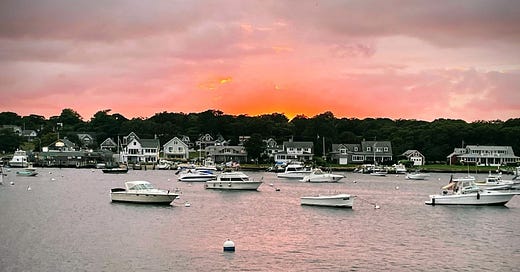Capturing a Sense of Place
Transform your fiction settings from a backdrop to a living, breathing presence
Settings can make or break a novel. When handled imaginatively, readers feel immersed in a world that breathes alongside the characters. When handled poorly, settings become forgettable. So how do you craft locations in which readers can truly feel engaged?
After writing nine novels, I've developed something of a rule. If I'm going to set significant portions of a story somewhere, I need to have lived there or visited often enough to have a real feel for the place. A depth of understanding that you can’t get otherwise comes from this kind of familiarity. You’ve seen how the place transforms from dawn to dusk, heard how locals and visitors talk, and navigated streets few tourists ever find.
For my most recent title CHLOE: A Novel of Secrets and Lies, I chose Martha's Vineyard, a place I’ve visited many times since childhood, as one of the primary settings. CHLOE is a romantic suspense novel, and as the photo I took above shows, few locations are more idyllic, with its mesmerizing sunsets and cool ocean breezes. That photo was taken while having dinner and drinks with friends at one of the many harbors on the island. Should be obvious why I chose it.
I also chose Potomac, Maryland, as another setting for the novel. I've lived in Maryland most of my life and frequently visited Potomac (I even house-hunted there once). These choices weren't laziness or convenience—they were strategy. Both were places I knew I could write about with authority and genuine feelings.
When choosing settings for your novel, ask yourself: Which places do I know well enough to recreate with authenticity on the page? Where have I accumulated tiny, telling details that breathe life into a setting?
Revisit or research with a writer's eye
Even if you know a place intimately, experiencing it as a setting for your novel is entirely different. I revisited Martha’s Vineyard and Potomac specifically for CHLOE and noticed things I'd overlooked for years.
In Potomac, I paid closer attention to street names and layouts. On the island, I noticed the exact shade of orange as the sun set over the ocean at the beach in Menemsha. Among the people, I checked out mannerisms and attire in coffee shops and local restaurants.
When you visit a place with your novel in mind, you should engage the senses more intentionally. What does the place smell like in the morning? What unexpected ocean sounds surround you on the beach? How does the breeze feel in your hair and against your skin? Using these sensory details in your novel will ground your readers in the reality you're creating.
Sometimes, you can't return to a place you're writing about. Or perhaps a portion of your novel requires a setting you've never visited. This is when research becomes your best friend.
For locations you can't visit but need to include, try some of the following approaches. Scour online resources, not just for facts but for personal accounts. Local publications and social media can help immensely here. Travel blogs often capture impressions that official websites miss. Study street-view maps to understand local geography. Most importantly, reach out to people who know the place well.
Still, I never make an unfamiliar location the main setting in my stories. When I include places I haven't experienced firsthand, they're usually locations my characters pass through or that get mentioned briefly. The emotional heart of your novel should always unfold in places you know well enough to recreate convincingly.
Make your setting another character
The real magic happens when you transform a setting from a backdrop to a living, breathing presence. In CHLOE, Martha's Vineyard isn't just where events occur. Readers have told me that the island seems like another character in the book. That makes me feel like I’ve done my job well. I wanted the island's summer vibe, chaos, and stark social class divisions to create conflict and drive the plot forward.
To achieve this in your writing:
Show how your setting affects your characters' choices. Does the environment limit them? Empower them? Challenge them?
Reveal how the place changes or has changed over time, whether through seasons, economic shifts, or physical development.
Create moments where characters must respond directly to their environment—whether a sudden storm, a traffic jam, or a chance encounter made possible only by a specific location.
Let your settings have moods that mirror or contrast with your characters' emotional states.
Include unusual or off-the-beaten-path destinations that lend character to the location.
The key is to make your settings more than a static backdrop. In CHLOE, when Potomac transforms from a picturesque estate surrounded by beautiful lawns to a gloomy property with rain-soaked grounds, that transformation propels the story forward as powerfully as any character's action could.
Don't dump the details
The quickest way to lose a reader is the dreaded "setting information dump"—those dull multi-paragraph-long descriptions that halt your narrative’s momentum. Instead, try to weave setting details into active scenes.
Rather than describe an island beach in isolation, show your character noticing how the sky looks as she sits on the sand and sketches the ocean view, or how the changing tide of the river reflects different moods of your character. Allow the setting to emerge through interaction rather than exposition.
Remember that your characters don't notice everything about their surroundings all at once. They perceive their environment gradually, noticing what matters to them in the moment. Let your readers discover the setting the same way.
Finally, you don't need to describe every last detail of your setting. In fact, sometimes less is more. A few vivid details will often do more work than an exhaustive description.
When I described Potomac in my novel, I had my character note the particular way light filtered through the tall trees on the estate or the sound of the raging waters of the river on a dark, quiet evening. The most powerful settings exist as a collaboration between writer and reader. You provide the essential elements then let your readers fill in the details.
Now, I'd love to hear from you. Which novels have transported you entirely to another location? What places in your own life do you think might make good settings in your stories?
If you enjoyed this, you might be interested in the The Story Setting Challenge. It originally ran in March and April, 2024 over four-weeks.






I love settings that are so integral to the story that it could not happen anywhere else. Like so many fiction readers, I want to be transported. As a writer, I want to take my readers to a new place. I write a series set in Acapulco but can't keep dashing there. YouTube and Google Earth helps me get down to street level.
These specific suggestions are so helpful! Particularly focusing on sensory details of a place with the novel in mind, and putting the characters into direct engagement with the setting. Looking forward to working on more of that. I’m working on a piece with setting that is fictionalized but near my home so lots of opportunities for research!